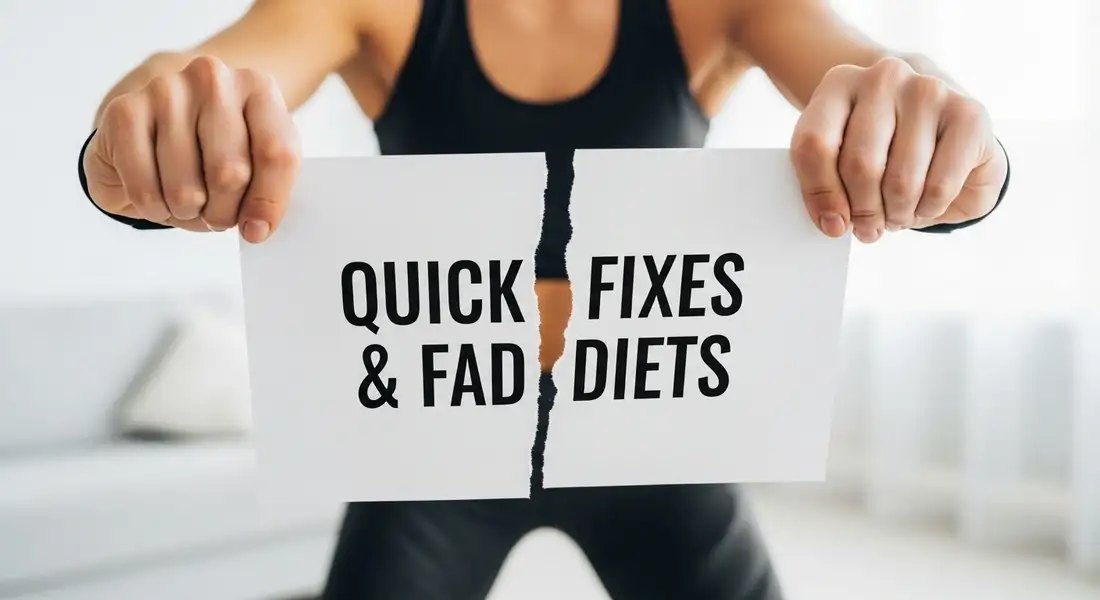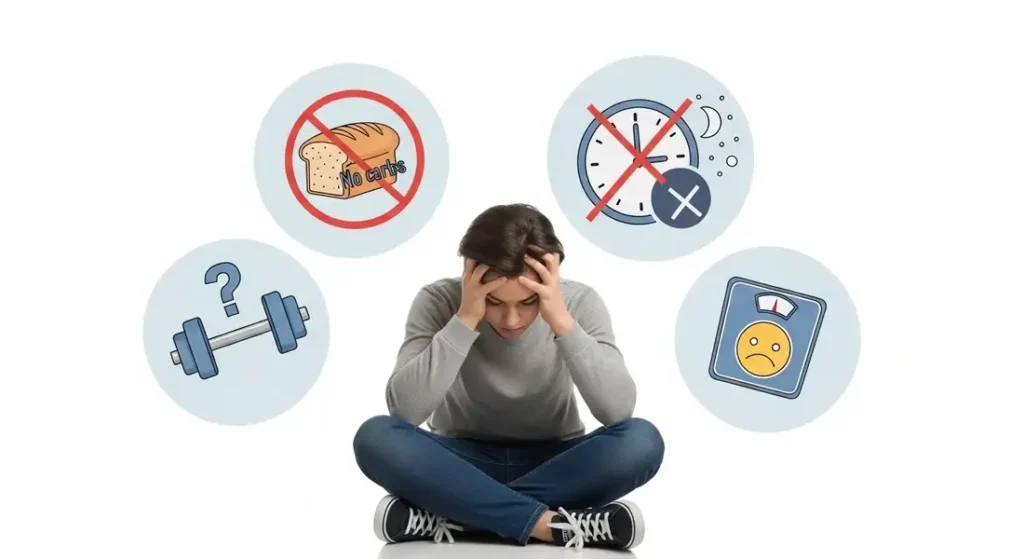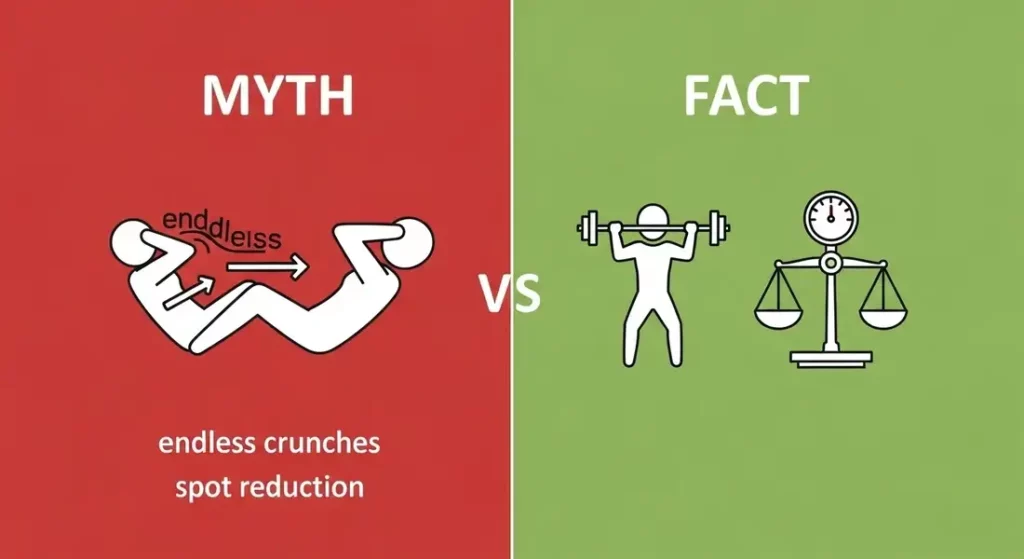The internet is a minefield of misinformation when it comes to weight loss.
This endless stream of conflicting advice is confusing, exhausting, and can make you feel like you’re doing everything wrong, even when you’re trying your best.

As a coach, my job is to cut through that noise.
This final piece in our Beginner’s Guide to Weight Loss at Home is your fact-checker.
We are going to take the most common weight loss myths, hold them up to the light, and debunk them with simple, science-backed truth.
Understanding these facts will free you from frustrating fads and allow you to focus on what truly works.
The Real Danger of Fitness Myths

Why is it so important to identify these myths?
Because they don’t just give you bad information—they actively sabotage your progress and your mental health.
- They Lead to Unsustainable Habits: Myths that encourage you to eliminate entire food groups (like carbs) or perform endless crunches set you up for a restrictive, miserable experience that is impossible to maintain long-term.
- They Cause Frustration and Quitting: When you follow a myth’s advice (like eating “fat-burning” foods) and don’t get the promised magical results, you’re likely to feel like a failure and give up entirely, believing that “nothing works for you.”
- They Create a Fear of Food: Complicated and contradictory rules can foster an unhealthy relationship with eating, causing you to fear certain foods and feel immense guilt, which is detrimental to your mental well-being.
By learning the truth, you reclaim your power and can finally focus on a simple, effective, and enjoyable approach.
Top 5 Weight Loss Myths Debunked

Myth #1: You Must Avoid Carbs to Lose Weight
The Myth: Carbohydrates are the single biggest cause of weight gain, and cutting them out is the only way to see results.
The Fact: The type and quantity of carbs matter, not the carbs themselves. Your body needs carbohydrates for energy.
This is perhaps the most persistent myth in the fitness world.
Your body breaks down carbohydrates into glucose, which is its preferred source of fuel, especially for your brain and muscles.
The problem isn’t carbs; it’s the overconsumption of highly processed, simple carbohydrates (like white bread, sugary drinks, and pastries) that lack fiber and other nutrients.
Complex carbohydrates (like oats, sweet potatoes, beans, and vegetables) are packed with fiber, which aids in digestion and helps keep you feeling full for longer.
Completely eliminating an entire macronutrient group is unsustainable and unnecessary.
A balanced approach is always more effective.
Myth #2: You Can “Spot Reduce” Fat from Certain Areas
The Myth: If you want to lose belly fat, you should do hundreds of crunches. If you want to slim your thighs, you should do endless leg lifts.
The Fact: Spot reduction is impossible. Your body loses fat systemically from all over.
You cannot choose where your body burns fat from.
When you are in a calorie deficit, your body draws energy from fat stores all over your body, and your genetics largely determine the order in which this happens.
While exercises like crunches will strengthen your abdominal muscles, they won’t specifically burn the layer of fat on top of them.
A comprehensive workout plan that combines full-body strength training and cardio is the only effective way to reduce overall body fat.
Myth #3: You Need to Do Hours of Cardio Every Day
The Myth: The more cardio you do, the more weight you will lose. Long, grueling sessions are the key to success.
The Fact: Consistency is far more important than duration. Overtraining can be counterproductive.
While cardio is excellent for burning calories, more is not always better.
Excessively long cardio sessions can increase your appetite, lead to burnout, and even cause muscle loss if not properly fueled.
As we’ve discussed, a combination of moderate cardio and strength training is the most effective and sustainable approach.
Strength training builds muscle, which boosts your metabolism long-term.
Remember, the goal is a healthy lifestyle, not a punishing daily routine.
Myth #4: Eating Late at Night Will Make You Gain Weight
The Myth: Any food you eat after a certain time (like 7 PM) automatically gets stored as fat because your metabolism slows down.
The Fact: A calorie is a calorie, regardless of what time you eat it. Your total daily intake is what matters.
Your metabolism doesn’t have an on/off switch that flips at sunset.
While it’s true that your metabolic rate is slightly lower while you sleep, it never shuts down completely.
Weight gain is caused by consuming more calories than you burn over the course of a day, a week, or a month—not by the timing of those calories.
The reason this myth persists is that late-night eating often involves mindless snacking on calorie-dense foods.
It’s the what and how much you’re eating, not the when.
Myth #5: “Fat-Burning” Foods Can Melt Away Pounds
The Myth: Certain foods like celery, grapefruit, or green tea have special properties that can magically burn fat off your body.
The Fact: No single food can burn fat. A calorie deficit is the only way to lose fat.
While some foods, like those containing caffeine, can cause a very slight and temporary increase in metabolic rate, the effect is too small to have any meaningful impact on weight loss.
The concept is a marketing gimmick. According to research from the National Institutes of Health, no food or supplement can magically burn fat.
The real “magic” comes from a consistent calorie deficit achieved by eating a balanced diet rich in nutrient-dense foods and engaging in regular physical activity.
Coach’s Toolkit – Your Fact-Checking Resources
The most powerful tool I can give you is the ability to think critically about the “advice” you see online.
When you hear a new, amazing claim, run it through this checklist.
- Who is the source? Is it a qualified professional (like a registered dietitian or certified strength coach) or someone trying to sell you a specific product?
- Does it sound too good to be true? Any claim that promises rapid, effortless results without fundamental changes to diet and exercise is a red flag.
- Where is the evidence? Look for links to actual scientific studies or reputable health organizations.
For truly reliable, science-backed information, here are a few of the best resources you can trust:
- Examine.com: An independent organization that analyzes thousands of studies on nutrition and supplements, presenting the data in an unbiased, easy-to-understand way.
- The National Institutes of Health (NIH) – Office of Dietary Supplements: Provides fact sheets on the real effectiveness and safety of countless weight loss ingredients.
- Precision Nutrition: An organization of world-renowned nutrition coaches that provides excellent, in-depth articles on every aspect of health and fitness.
The Coach’s Final Word – The One Truth That Matters
If you forget everything else, remember this: the antidote to every myth, fad, and quick fix is the boring, un-sexy, but incredibly effective truth.
Consistency and patience are the secret.
The formula for weight loss is simple (though not always easy):
- Create a sustainable calorie deficit with nutrient-dense foods.
- Incorporate a mix of cardio and strength training that you can stick with.
- Get enough rest and manage your stress.
- Be patient and trust the process.
That’s it. That’s the whole game.
Return to the Beginner’s Guide to Weight Loss at Home to reinforce your understanding of these core principles.
What is the most confusing or persistent weight loss myth you’ve ever heard? Share it in the comments below!
